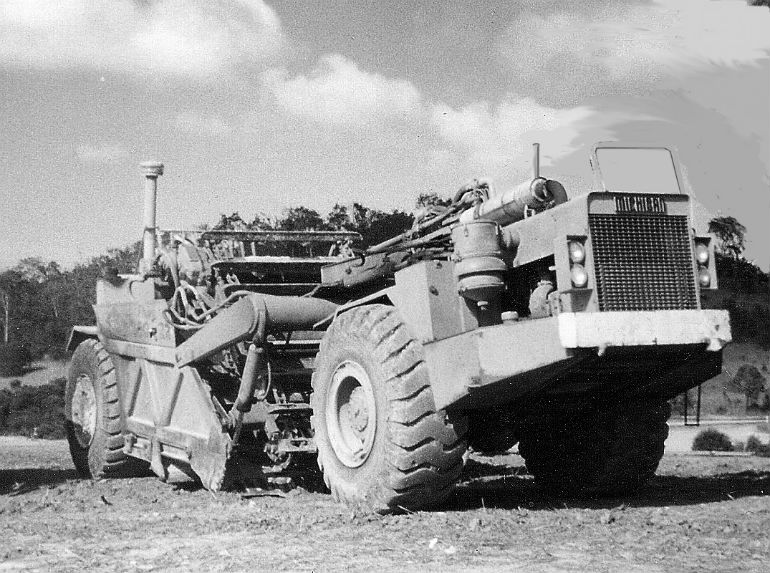Working on the principle that two engines are better than one, Michigan introduced its model 110HT twin powered elevating scraper in 1970.
A modification of the already successful model 110-11 elevating scraper, the 110HT featured a bigger bowl, larger tires and of course, loads more power to handle grades and poor underfoot conditions.
The original Michigan 110 was introduced in 1957 and the 110H elevator arrived on the scene in 1965 featuring a 12 cubic yard bowl which was designed and manufactured by Hancock.
Hancock, the originator of the elevating scraper, had become a subsidiary of Clark in 1966 and Clark had also purchased Michigan thus keeping everything “in the family” so to speak.
It was decided that the market could use a twin powered elevating scraper and a model 110-15 was taken from production and modified with an extra engine and transmission to gauge productivity & serviceability.
This experimental machine proved the concept and accordingly the model 110HT was put into production
Rated at 16 cubic yards capacity, the 110HT had no competition in its size class, the closest competitor being Wabco’s model 252FT which was a considerably larger and heavier machine.
As a result, sales of the 110HT were steady throughout the period of its production..
In a bizarre twist of marketing, the 110HT was also sold under the Hancock brand name as the model 294.
This machine was almost identical in all respects to the 110HT but was only offered for sale for approx 3 years, Clark deciding that it was all just to confusing for potential buyers.
Power for the 110HT came from two 144 horsepower General Motors Detroit Diesel 4-71N naturally aspirated diesels.
These were connected to identical Clark 5-speed full powershift transmissions which could move the 110HT along at a top speed of 28 mph.
Clark planetary axles were of course utilized and these featured a 26.5×29 tire as standard with a 26.5×25 being offered as an option.
Brakes were of the full-air operated S-cam type on both axles.
The bowl was a typical Hancock product – strong, durable and well designed.
Power for the elevator assembly was provided by a single hydraulic motor which turned the 15 flight elevator at approx 260 rpm. The elevator was reversible.
Ejection was by sliding floor and bulldozer ejector with a strike-off blade which dropped down as the floor retracted to aid in trimming up the fill.
Most Hancock-built scrapers featured this useful gadget
Four teeth could be bolted to the cutting edge to aid in breaking up tough soil.
As far as comforts went, the 110HT operator did not fare too badly.
An air suspension seat was standard equipment and a heater and cab were offered as options.
To monitor vital machine functions a comprehensive set of gauges were provided for tractor and scraper.
Visibility was average to the right of the machine but good to the cutting edge where it mattered.
Steering was via two hydraulic rams placed high up on the gooseneck and these permitted a full 90 degree turn in either direction.
Due to the machines width and axle loading it was usually transported from job to job and was rarely roaded.
Never one of the “big three” in motor scraper manufacturing (Euclid/Terex, Caterpillar and Wabco’s sales dwarfed that of Clark’s), Clark-Michigan still turned out a very respectable and reliable product.
This fact can be evidenced by the number of Michigan scrapers still operating long after Clark ceased producing them in 1983.
Total production of the Clark-Michigan 110HT was approx. 1000 units.
The New Zealand Connection
At least 7 Clark-Michigan 110HT elevating scrapers were imported by NZ franchise holder Andrews & Beavan and the author knows of two still in operation in the Auckland region alone.
They have been dispersed throughout New Zealand with many originally delivered to customers in the lower North Island and South Island.
Most, if not all of the 110HT’s imported into New Zealand had the optional cab fitted.
These machines were a real performer in their day and it’s good to see (and hear) the occasional one still operating.
For the Diecast Model Collector
There are currently no models available in any scale of a Michigan 110HT (or any other Michigan scrapers for that matter aside from a 1:150 scale type 210 issued in the early 1970s).
Hopefully one of the many model manufacturers will redress this oversight before too long.
Brief Specifications – Michigan 110HT
Engine(s): 2 x GM Detroit Diesel 4-71N 4-cylinder, naturally aspirated diesel engines rated at 144 flywheel horsepower each.
Transmission(s): 2 x Clark 5-speed full powershift transmissions
Brakes: Air operated S-Cam shoe type on all wheels
Tires: 26.5×29
Top Speed: 28 mph
Steering: Two hydraulic cylinders, 90° left & right
Capacity: 16 cubic yards
Elevator Drive: Single hydraulic motor with gear reduction
No of Flights: 15
Turning Circle: 31’ 6”
Length: 37’ 8”
Width: 9’ 2”
Height: 12’ 8”
Operating Weight: 23.5 tons (empty), 40 tons (loaded)


Parting words from Jeremy Sole- a final column